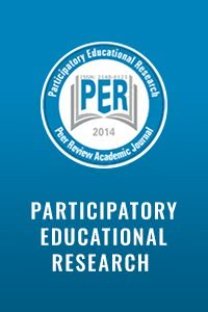The State Of Science High School Students’ Associating Physics Lesson With Life And With Other Science Lessons
physics education science education, science hıgh school,
___
- Abbott, S. & Ryan, T., (1999). Constructing Knowledge, Reconstructing Schooling, Educational Leadership, 66-69.
- Akkoyunlu, B. (1996). Computer Literacy Competency With The Effects Of Integrated To The Existing Curriculum Student Achievement And Attitude. Hacettepe University Journal of Education. 12, 127-134.
- Akpınar, E., & Ergin, Ö. (2004). A Sample Instruction Towards Integration of Physics, Chemistry and Biology in Science Teaching, Marmara University Journal of Educational. 19, 1-16.
- Aydın, H., & Uşak, M. (2003). The Importance of the Investigation of Alternative Conceptions in Science Classes: A Theoretical Aproach. Pamukkale University Journal of Education. 13(1), 121.
- Göçmençelebi, İ.Ş., & Özkan, M. (2011). Does the Use of Technology and Reading Scientific Publications Affect the Ability to Relate Science Lesson Knowledge to Daily Life A Comparative Study of Turkish Primary School Students. Uludağ University Journal of Education. 24(1), 287-296.
- Gök, T., & Sılay, İ. (2008). The Effects of Problem- Solving Strategies on Students’ Achievement, on the Cooperative Learning Groups in Physics Teaching, H. U. Journal of Education. 34, 116-126.
- Gönen, S., Kocakaya, S. (2005). The Comparison of Physics Achivements and Computer Attitudes of The First Year Students of A High School According to Two Different Instruction Methods, Pamukkale University Journal of Education. 17(17), 11-19. Retrived from http://pauegitimdergi.pau.edu.tr/DergiPdfDetay.aspx?ID=76 (27.07.2016)
- Güneş, T., & T.Akdağ, F. (2016). Determination of Perceptions of Science High School Students on Energy and Their Levels of Interdiciplinary Association, International Journal of Social Sciences and Education Research. 2(2), 2016.
- Gürdal, A., Bayram, H., & Şahin, F. (1999). Teaching The Energy Issue With Integration in Primary Schools, Karadeniz Technical University, 3rd National Symposium of Science Education, Ankara: MEB, 204-208.
- Gürel, Z., Güven, İ., & Gürdal, A. (2003). Evaluation of Skills of Skills of High School Students in Interpreting Daily Life Events in Lighth of the Knowledge They Learn in Their Physics Lessons. Marmara University Journal of Educational. 18, 65-78.
- Köseoğlu, F., Tümay, H., & Üstün, U. (2010). Paradigm Changes About Nature of Science and New Teaching Aproaches, Ahi Evran University Journal of Kırşehir Education Faculty. 11(4), 129-162.
- Lederman, N.G. (1992). Students and teachers conceptions of the nature of science. Journal of Research in Science Teaching. 29(4), 351-359.
- Secondary Education Institutions of Ministry of Education. (2013). Retrived from http://www.resmigazete.gov.tr/eskiler/2013/09/20130907-4.htm (28.07.2016)
- Secondary Physics Curriculum. 2013. http://ttkb.meb.gov.tr/www/guncellenen-ogretim-programlari/icerik/151 (08.08.2016)
- ÖSYM, 2016. Retrived From. http://dokuman.osym.gov.tr/pdfdokuman/2016/YGS/2016_YGS_Sayisal_Bilgiler.pdf (27.07.2016)
- Seçgin, F., Yalvaç, G., & Çetin, T. (2010). Environmental Problem Perceptions of 8th Grade Students Through Cartoons. International Conference on New Trends in Education and Their Implications. 11-13. ISBN: 978 605 364 104 9
- Sherman, S.J. (2000). Science and Science Teaching. Newyork: Houghton Mifflin Company.
- Şahin, F., & Oktay, A. (1996). Related Conceptual Change With Cell Respiration In Primary Schools. Marmara University Journal of Educational. 8, 227-236.
- Taşlıdere, E., & Eryılmaz, A. (2012). Development of Attitude Scale Towards Simple Electric Circuits and Assessment of Students', Journal or Turkish Science Education. 9(1), 31-46.
- Yıldırım, A. (1996). Interdisciplinary Education Concepts And Its Consequences About The Results Programs, Hacettepe University Journal of Education. 12, 89-94.
- Yücel, S., Seçken, N., & Morgil, F.İ. (2001). High School Students Measurement Of Learning Degree In Symbols, Constants And Units Of Chemistry Teaching, G.Ü. Journal of Gazi Educational Faculty. 21(2), 113-123.
- ISSN: 2148-6123
- Yayın Aralığı: Yılda 6 Sayı
- Başlangıç: 2014
- Yayıncı: Özgen KORKMAZ
Gürbüz OCAK, İjlal OCAK, Serkan BOYRAZ
Gürbüz OCAK, İjlal OCAK, Nil AKYOL
Büşra BAKŞOĞLU, Orhan KARAMUSTAFAOĞLU
Gürbüz OCAK, İjlal OCAK, Serkan BOYRAZ
